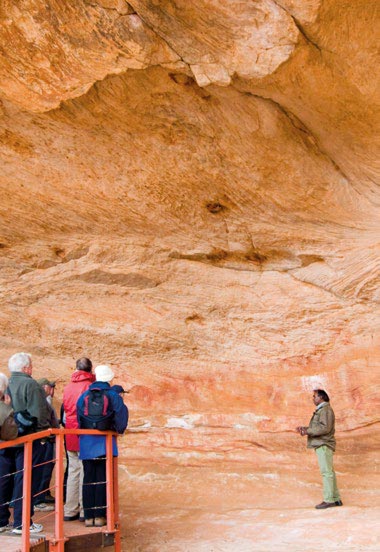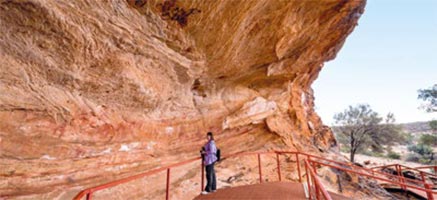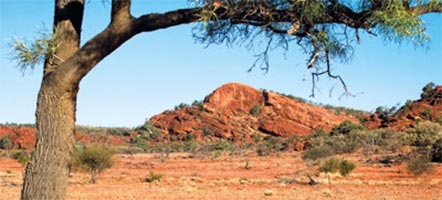 Mutawintji National Park, which includes Mutawintji Historic Site, is an extremely special place for the living culture and spirituality of Indigenous Australians. The historic site has an extensive history as an Aboriginal ceremonial site relevant to many indigenous groups from the immediate and surrounding country. Its significance was further consolidated by a blockade in the 1980’s to regain traditional custodianship of the Historic Site. The park also provides the visitor with many wonderful walks through magnificent gorges and ephemeral streams in addition to wonderful art sites.
Mutawintji National Park, which includes Mutawintji Historic Site, is an extremely special place for the living culture and spirituality of Indigenous Australians. The historic site has an extensive history as an Aboriginal ceremonial site relevant to many indigenous groups from the immediate and surrounding country. Its significance was further consolidated by a blockade in the 1980’s to regain traditional custodianship of the Historic Site. The park also provides the visitor with many wonderful walks through magnificent gorges and ephemeral streams in addition to wonderful art sites.
Mutawintji National Park is one of the most moving and culturally significant areas of NSW and should be put towards the top of any visitor wish list. The wonderful sandstone ridges and gorges fills the senses with wonderment and it is one of those places where you can feel the cultural significance of the area and the land; and why it so significant to the Indigenous culture.
Mutawintji National Park and the Mutawintji Historic site is an extremely special place for the living culture and spirituality of Indigenous Australians The historic site has an extensive history as an Aboriginal ceremonial site relevant to many indigenous groups from the Darling River Region and beyond.
The historic area (only accessible with a guide) is truly evocative as one is able to experience the living history of the place which has been the site of indigenous ceremonies for many thousands of years. Its significance was further bolstered by a 1980’s blockaded by the Barkindji people to have the area handed back to the traditional custodians and managed by the Mutawintji Local Aboriginal Land Council. This came to fruition in 1998.
The Mutawintji Historic site tour is a must for any visitor to this area (Wednesday and Saturdays – April to October and are run by the Mutawintji Local Aboriginal Land Council). Access to the area is only possible with a guide.
 The park also provides the visitor with many wonderful walks through magnificent gorges and ephemeral streams in addition to wonderful art sites. It also provides the perfect stopover for the traveller by providing a wonderfully sited camping area thereby allowing a ‘less-rushed’ approach to what this park has to offer including:
The park also provides the visitor with many wonderful walks through magnificent gorges and ephemeral streams in addition to wonderful art sites. It also provides the perfect stopover for the traveller by providing a wonderfully sited camping area thereby allowing a ‘less-rushed’ approach to what this park has to offer including:
1) The Mutawintji Gorge Walk – a spectacular walk up the River gum lined creek to the permanent water supply in the gorge.
2) Homestead Creek Walk: a wonderful 4-5hr loop (steep at times) passing Thaaklatjika (Wrights Cave) full of paintings, stencils and engravings, The Rockpools, Homestead Gorge and the Byngnano Range.
3) Old Coach Road Drive: This old mail coach road finishes at a wonderful picnic spot and walking trail of about 3kms will lead the visitor past Wana Karnu (Boomerang Rock) and the majestic Split Rock.
 The main physical feature of the park is the mulga covered Byngnano Range with its colourful gorges, rock pools and River-Gum lined creek beds. Scattered among the caves and overhangs are galleries of Aboriginal rock art and engravings.
The main physical feature of the park is the mulga covered Byngnano Range with its colourful gorges, rock pools and River-Gum lined creek beds. Scattered among the caves and overhangs are galleries of Aboriginal rock art and engravings.
Mutawintji NP is one of only a few reliable water sources in the whole area and as such it is a drawing point for fauna like Kangaroos, Emus, Wedge-tailed eagles, Peregrine Falcons, Corellas, Zebra Finches, Apostle Birds and the very rare Centralian Ranges Rock Skink
Mutawintji National Park is about 2 hrs drive (75km off the Barrier Highway) north-east of Broken Hill. (Dry weather road). Access from Wilcannia is via White Cliffs (75km sealed). The route to Mutawintji National Park via White Cliffs (155 km – about 2.5 hours unsealed) makes for a wonderful adventure to visit these two icons of Outback NSW.
For more information on Mutawintji National Park – GPS:-31.285265* 1142.237459*